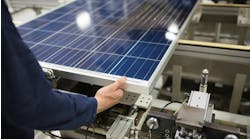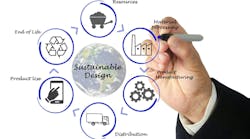Clean-energy storage & targeting net-zero manufacturing: A Q&A with Schneider Electric's Cory Lichtenberger
Earlier this year the UN released its IPCC report, highlighting the need for countries to establish a clear path to sustainability and net-zero infrastructure by 2050. The report spotlights net-zero mitigation options to limit global GHG emissions and the need to scale up eco-friendly actions in the industrial sector.
We wanted to dive deeper, so we connected with Cory Lichtenberger, vice president US strategy at Schneider Electric. Take a look…
Smart Industry: What unique challenges / opportunities are there in the manufacturing space when it comes to targeting net-zero?
Cory: Without a doubt, the manufacturing sector is the largest contributor to many of our current environmental issues, both directly and indirectly. The state of the manufacturing industry is dependent on a variety of factors—product design, day-to-day operations, regular maintenance, and current supply chains—but when it comes to creating a sustainable manufacturing business, it all comes down to the decisions from the top, and around 2/3 of leading organizations have carbon neutral targets.
But how are these sustainability efforts being implemented? The responsibility primarily falls on the C-suite, with initiatives spread relatively evenly across design, operations, maintenance and supply chain business functions. These collaborative initiatives are crucial to meeting sustainability targets and pledges for the manufacturing sector.
That’s why the IPCC report is so crucial—it’s a dire warning to the business leaders of the world, especially within the manufacturing sector, that our efforts need to increase exponentially. As the report dictates, there is sufficient global capital to close the global investment gaps but there are barriers to redirecting capital to climate action. Leaders must act now.
Smart Industry: What are clean energy-storage technologies and how do they come into play here?
Cory: With the climate crisis at an all-time high, there (thankfully) has been increased investment in clean-energy storage. Energy storage allows us to store clean energy to use at a later date, while at the same time increasing reliability, controlling costs, and creating a more resilient grid. While storage costs are decreasing every year, the advancement and adoption of long-duration energy technologies is necessary for the mass deployment of clean energy sources.
To achieve mass-adoption of these energy storage systems, they must be implemented at large scale for commercial, industrial and residential buildings.
Smart Industry: How is energy infrastructure evolving alongside the larger digital transformation?
Cory: Digital transformations have changed our current business models, products and strategies and has impacted virtually every industry—especially those that are energy-intensive. In the future, it will drive our society to rely much more on a stable electrical grid due to the growth in electric vehicles, smart cities and heavy industrial electrification.
The energy industry has already greatly improved its antiquated infrastructure to increase grid reliability and power the new electric world, but as society only becomes more digital, our energy infrastructure must evolve further. Consumers are increasingly transforming their lives, digitally, through electric vehicles and smart-home technology. This transformation coincides with the digitization of the energy sector—integrating data and machine learning for easier and more reliable maintenance, creating renewable smart grids and enabling the consumers to become ‘prosumers’ by creating their own energy through technology-forward tools like bidirectional EV charging and solar panels.
Leading this charge is Electricity 4.0, Schneider Electric’s initiative to electrify homes, buildings, data centers, industries, infrastructure, and grids by combining data-driven metering and monitoring and smart devices, apps, analytics, and software to deploy smart, green energy. Electricity 4.0 accelerates the evolution of our energy infrastructure and the larger industry transformation simultaneously by creating an ecosystem of tools for every industry to electrify its systems.
Smart Industry: What is cause for optimism here?
Cory: The digitalization of our energy infrastructure is a key enabler to reaching net zero. By upgrading our infrastructure to utilize green, sustainable energy sources and transforming the way our energy is produced, distributed and consumed, there’s still time to reduce our global emissions, according to the IPCC report.
Luckily, our society already has the tools—like installing solar panels and smart-home ecosystems for homeowners and decarbonizing buildings—to curb our impact on the planet. We just need to implement them. This will be led by the digital transformation of our energy sector as well as the larger industrial digital transformation.



